Messages Content in Flutter Chat (SfChat)
26 Mar 202524 minutes to read
This section explains the customization options available for modifying the incoming and outgoing messages in the chat widget.
Messages
The messages property is the data source of the Chat widget which accepts the list of ChatMessage objects to be displayed as incoming or outgoing messages based on the outgoingUser property value.
Each ChatMessage contains the following message information,
-
text- This defines the actual content of the message. -
time- This indicates the time the message was sent. -
author- This includes details about the author of the message, such as their name and user avatar or profile image.
@override
Widget build(BuildContext context) {
return Scaffold(
body: SfChat(
messages: <ChatMessage>[
ChatMessage(
text: 'Hi! How’s your day?',
time: DateTime(2024, 08, 07, 9, 0),
author: const ChatAuthor(
id: '123-001',
name: 'John Doe',
),
),
ChatMessage(
text: 'Good! Just relaxing.',
time: DateTime(2024, 08, 07, 9, 5),
author: const ChatAuthor(
id: '123-002',
name: 'Jane Smith',
),
),
ChatMessage(
text: 'Any plans later?',
time: DateTime(2024, 08, 07, 9, 10),
author: const ChatAuthor(
id: '123-001',
name: 'John Doe',
),
),
],
outgoingUser: '123-001',
),
);
}
Additionally the message can be extended to include more detailed information about the respected chat message.
In the following example, included the user’s display name additionally in the existing message.
@override
void initState() {
super.initState();
_messages = [
ChatMessageExt(
text: 'Hi! How’s your day?',
time: DateTime(2024, 08, 07, 9, 0),
author: const ChatAuthor(
id: '123-001',
name: 'John Doe',
),
displayName: 'JD',
),
ChatMessageExt(
text: 'Good! Just relaxing.',
time: DateTime(2024, 08, 07, 9, 5),
author: const ChatAuthor(
id: '123-002',
name: 'Jane Smith',
),
displayName: 'JS',
),
ChatMessageExt(
text: 'Any plans later?',
time: DateTime(2024, 08, 07, 9, 10),
author: const ChatAuthor(
id: '123-001',
name: 'John Doe',
),
displayName: 'JD',
),
];
}
@override
Widget build(BuildContext context) {
return MaterialApp(
home: Scaffold(
body: SfChat(
messages: _messages,
outgoingUser: '123-001',
messageAvatarBuilder: (context, index, message) {
if (message is ChatMessageExt) {
return CircleAvatar(
radius: 20,
child: Text(
message.author.name.isNotEmpty
? message.displayName
: '?',
style: const TextStyle(
color: Colors.black87,
fontWeight: FontWeight.bold,
),
),
);
}
return Container();
},
),
),
);
}
class ChatMessageExt extends ChatMessage {
const ChatMessageExt({
required super.text,
required super.time,
required super.author,
required this.displayName,
});
final String displayName;
}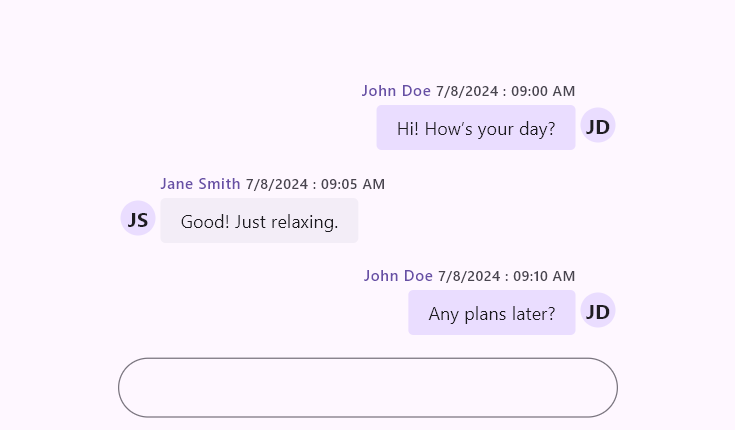
Suggestions
The Suggestions property allows you to add a list of suggestion items to a message in the message list. The selected suggestion item can be displayed in the chat interface as either an incoming or outgoing message, depending on the user who selected it. The suggestion layout, background color, and other properties can be customized.
@override
Widget build(BuildContext context) {
return Scaffold(
body: SfChat(
messages: <ChatMessage>[
ChatMessage(
text: 'Hi! How’s your day?',
time: DateTime(2024, 08, 07, 9, 0),
author: const ChatAuthor(
id: '123-001',
name: 'John Doe',
),
),
ChatMessage(
text: 'Good! Just relaxing. How are you?',
time: DateTime(2024, 08, 07, 9, 5),
author: const ChatAuthor(
id: '123-002',
name: 'Jane Smith',
),
suggestions: <ChatMessageSuggestion>[
const ChatMessageSuggestion(data: 'All good!'),
const ChatMessageSuggestion(data: 'Doing well!'),
const ChatMessageSuggestion(data: 'I\'m Fine'),
],
),
],
outgoingUser: '123-001',
),
);
}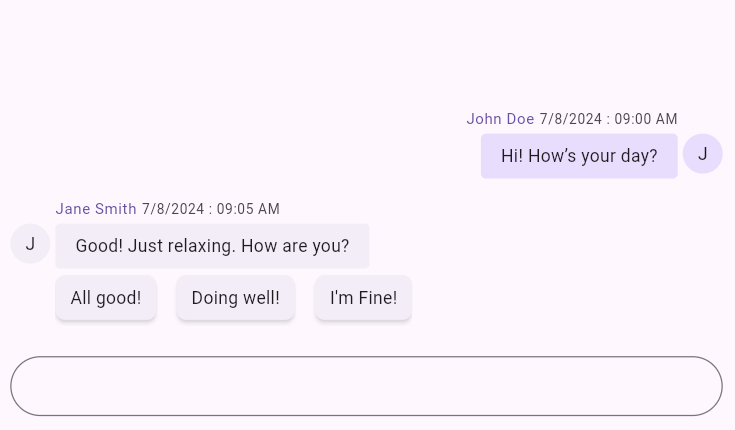
Outgoing user
The outgoingUser property represents the user who is sending messages. It should be set to the unique ID of the user, which corresponds to the id property of the ChatAuthor. This property plays a crucial role in identifying and distinguishing messages sent by different users.
The name may be repeated within the group, but the ID is unique to each user.
@override
Widget build(BuildContext context) {
return Scaffold(
body: SfChat(
messages: <ChatMessage>[
ChatMessage(
text: 'Hi! How’s your day?',
time: DateTime(2024, 08, 07, 9, 0),
author: const ChatAuthor(
id: '123-001',
name: 'John Doe',
avatar: NetworkImage('https://randomuser.me/api/portraits/men/1.jpg'),
),
),
ChatMessage(
text: 'Good! Just relaxing.',
time: DateTime(2024, 08, 07, 9, 5),
author: const ChatAuthor(
id: '123-002',
name: 'Jane Smith',
avatar: NetworkImage('https://randomuser.me/api/portraits/women/1.jpg'),
),
),
ChatMessage(
text: 'Any plans later?',
time: DateTime(2024, 08, 07, 9, 10),
author: const ChatAuthor(
id: '123-003',
name: 'John Doe',
avatar: NetworkImage('https://randomuser.me/api/portraits/men/4.jpg'),
),
),
],
outgoingUser: '123-001',
),
);
}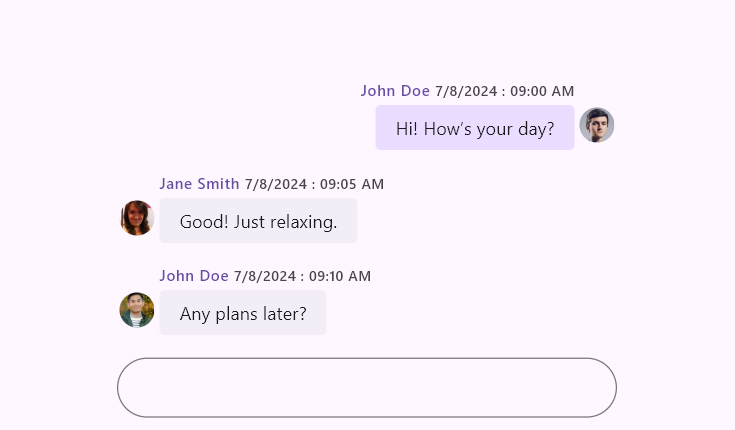
Message settings
Based on the outgoingUser property, the messages are distinguished as either incoming or outgoing. The following options are available to customize the display settings of the message bubble.
You must import the
intlpackage for handlingtimestampFormatin your chat application.
Author name
The showAuthorName property is used to show or hide the author’s name for the message. Defaults to true.
Time stamp
The showTimestamp property is used to show or hide the time the message was sent. The time format can be customized using timestampFormat. Defaults to true.
Time stamp format
The timestampFormat property is used to specify the date format for the sending time (timestamp). The default value is DateFormat(‘d/M/y : hh:mm a’).
@override
Widget build(BuildContext context) {
return Scaffold(
body: SfChat(
messages: <ChatMessage>[
ChatMessage(
text: 'Hi! How’s your day?',
time: DateTime(2024, 08, 07, 9, 0),
author: const ChatAuthor(
id: '123-001',
name: 'John Doe',
),
),
ChatMessage(
text: 'Good! Just relaxing.',
time: DateTime(2024, 08, 07, 9, 5),
author: const ChatAuthor(
id: '123-002',
name: 'Jane Smith',
),
),
ChatMessage(
text: 'Any plans later?',
time: DateTime(2024, 08, 07, 9, 10),
author: const ChatAuthor(
id: '123-001',
name: 'John Doe',
),
),
],
outgoingUser: '123-001',
incomingMessageSettings: ChatMessageSettings(
timestampFormat: DateFormat('MMM d, h:mm a'),
),
outgoingMessageSettings: ChatMessageSettings(
timestampFormat: DateFormat('h:mm a'),
),
),
);
}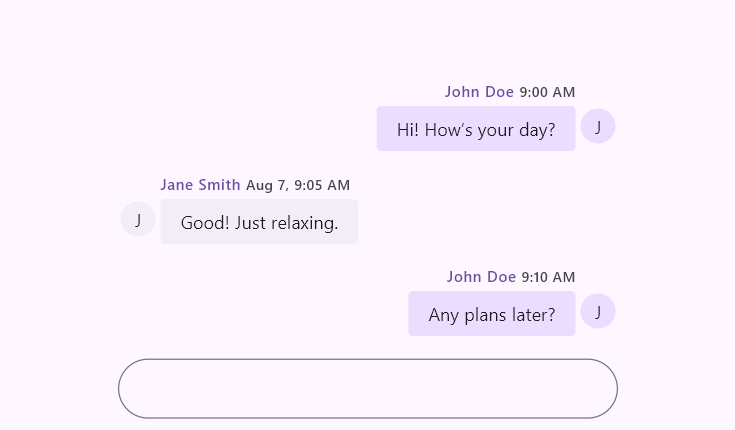
Author avatar
The showAuthorAvatar property is used to show or hide the author’s image for the message. Defaults to true.
@override
Widget build(BuildContext context) {
return Scaffold(
body: SfChat(
messages: <ChatMessage>[
ChatMessage(
text: 'Hi! How’s your day?',
time: DateTime(2024, 08, 07, 9, 0),
author: const ChatAuthor(
id: '123-001',
name: 'John Doe',
),
),
ChatMessage(
text: 'Good! Just relaxing.',
time: DateTime(2024, 08, 07, 9, 5),
author: const ChatAuthor(
id: '123-002',
name: 'Jane Smith',
),
),
ChatMessage(
text: 'Any plans later?',
time: DateTime(2024, 08, 07, 9, 10),
author: const ChatAuthor(
id: '123-001',
name: 'John Doe',
),
),
],
outgoingUser: '123-001',
incomingMessageSettings: const ChatMessageSettings(
showAuthorAvatar: true,
),
outgoingMessageSettings: const ChatMessageSettings(
showAuthorAvatar: false,
),
),
);
}![]()
Text styles
The textStyle property is used to define the text style for content inside the message.
Header text style
The headerTextStyle property is used to define the text style for the header of the message, including the username and timestamp.
Background color
The backgroundColor property is used to specify the background color of the content area within the message.
@override
Widget build(BuildContext context) {
return Scaffold(
body: SfChat(
messages: <ChatMessage>[
ChatMessage(
text: 'Hi! How’s your day?',
time: DateTime(2024, 08, 07, 9, 0),
author: const ChatAuthor(
id: '123-001',
name: 'John Doe',
),
),
ChatMessage(
text: 'Good! Just relaxing.',
time: DateTime(2024, 08, 07, 9, 5),
author: const ChatAuthor(
id: '123-002',
name: 'Jane Smith',
),
),
ChatMessage(
text: 'Any plans later?',
time: DateTime(2024, 08, 07, 9, 10),
author: const ChatAuthor(
id: '123-001',
name: 'John Doe',
),
),
],
outgoingUser: '123-001',
incomingMessageSettings: const ChatMessageSettings(
backgroundColor: Color(0xFFE1F5FE),
),
outgoingMessageSettings: const ChatMessageSettings(
backgroundColor: Color(0xFFF1F8E9),
),
),
);
}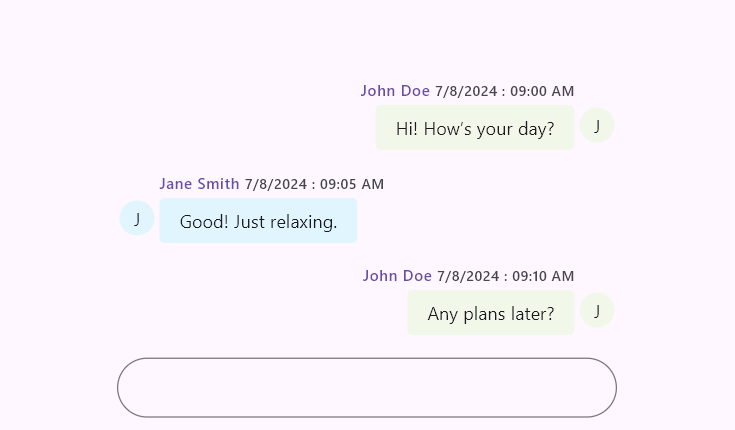
Shape
The shape property is used to define the shape of the content area of the message, such as rounded or custom shapes.
@override
Widget build(BuildContext context) {
return Scaffold(
body: SfChat(
messages: <ChatMessage>[
ChatMessage(
text: 'Hi! How’s your day?',
time: DateTime(2024, 08, 07, 9, 0),
author: const ChatAuthor(
id: '123-001',
name: 'John Doe',
),
),
ChatMessage(
text: 'Good! Just relaxing.',
time: DateTime(2024, 08, 07, 9, 5),
author: const ChatAuthor(
id: '123-002',
name: 'Jane Smith',
),
),
ChatMessage(
text: 'Any plans later?',
time: DateTime(2024, 08, 07, 9, 10),
author: const ChatAuthor(
id: '123-001',
name: 'John Doe',
),
),
],
outgoingUser: '123-001',
incomingMessageSettings: const ChatMessageSettings(
shape: RoundedRectangleBorder(
borderRadius: BorderRadius.all(Radius.circular(5)),
),
),
outgoingMessageSettings: const ChatMessageSettings(
shape: RoundedRectangleBorder(
borderRadius: BorderRadius.all(Radius.circular(10)),
),
),
),
);
}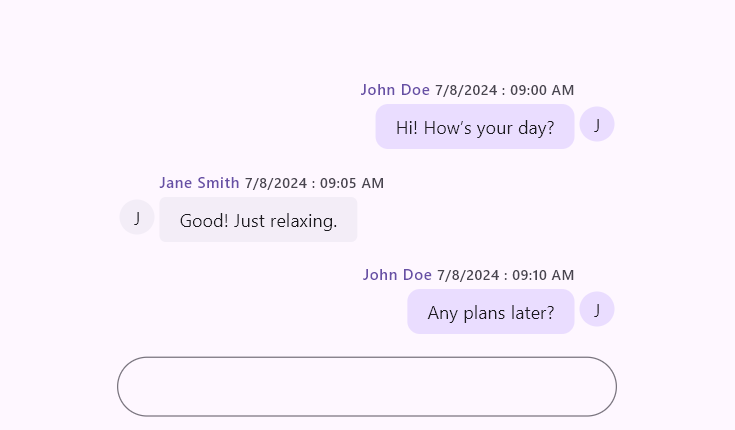
Width factor
The widthFactor property is used to define the width factor of the message relative to available width. The width value should be between 0 and 1. Default value is 0.8.
Avatar size
The avatarSize property is used to specify the size of the author’s avatar in the message. Defaults to Size.square(32.0).
Margin
The margin property is used to define the space inside the message between the border and content. Defaults to EdgeInsets.all(2.0).
Padding
The padding property is used to specify the padding within the content area of the message, controlling spacing around the text. Defaults to EdgeInsets.symmetric(horizontal: 16.0, vertical: 8.0).
Avatar padding
The avatarPadding property is used to define the padding around the author’s avatar within the message.
Header padding
The headerPadding property is used to specify the padding around the header section of the message, including the username and timestamp. Defaults to EdgeInsetsDirectional.only(top: 14.0, bottom: 4.0).
Footer padding
The footerPadding property is used to define the padding around the footer section of the message. Defaults to EdgeInsetsDirectional.only(top: 4.0).
You can refer to our Flutter Chat feature tour page for its groundbreaking feature representations. You can also explore our Flutter Chat example which demonstrates conversations between two or more users in a fully customizable layout and shows how to easily configure the chat with built-in support for creating stunning visual effects.
See Also
- You can also customize the Message shapes and colors properties of both
incomingMessageSettingsandoutgoingMessageSettingsusingSfChatThemeby wrapping withSfChat.